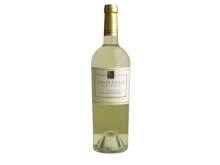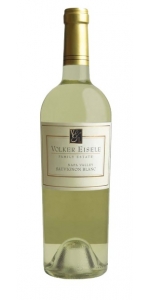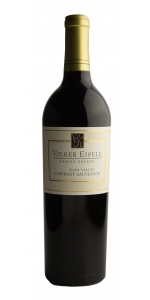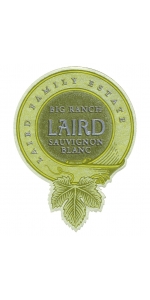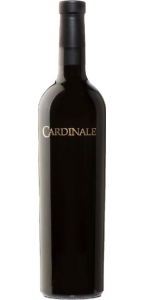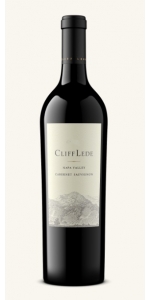Volker Eisele Sauvignon Blanc Napa Valley 2024
6 bottles with free shipping for: $270.00
12 bottles with free shipping for: $480.00
| BUY MORE! SAVE MORE! | ||||||||||||||||||||
|
| Country: | United States |
| Regions: | California California (Napa) |
| Winery: | Volker Eisele Family Estate |
| Grape Type: | Sauvignon Blanc |
| Organic: | Yes |
| Vintage: | 2024 |
| Bottle Size: | 750 ml |
The 2023 Sauvignon Blanc shows abundant aromas of Meyer lemon, passionfruit, and jasmine. In the mouth, the Semillon shows itself with a rich, deliciously textured palate with flavors of orange blossom, mandarin oranges, and a wet stone minerality
Volker Eisele Family Estate creates enticing wines from the Chiles Valley District of the Napa Valley. Organically farmed since 1974, the vineyard reflects the passion of the Eisele Family’s commitment to grow exceptional grapes and to produce elegant estate wines.
VINEYARD
Volker Eisele Family Estate is situated in the Chiles Valley District, a sub-appellation of the Napa Valley American Viticultural Area. Cloaked in frequent Pacific fog, and with elevations of 600-1200 feet, the Chiles Valley District is one of the cooler areas of the Napa Valley resulting in a long growing season. The valley’s perfect cabernet climate enhances the development of wines with subtle flavors, full body, and overall complexity.
The Estate’s sixty acres of vineyard grow at elevations of 900 to 1100 feet on east, west and south facing slopes as well as on the valley floor. Soils vary from clay-loam to shale. After purchase of the vineyard property, the Eisele’s began an extensive redevelopment and restoration of both the vineyard acreage and the riparian corridors. Presently 72% of the vineyard is planted in Cabernet Sauvignon, 12.5% Merlot, 10.5% Cabernet Franc, 3% Semillon and 2% Sauvignon Blanc. Seven different Cabernet clones have been incorporated to provide diversity of flavor.
Since 1974 the Eisele’s have enriched the vineyard soils through use of organic farming practices. No herbicides, pesticides or chemical fertilizers have been used. The vineyard is certified as organic by both the California Certified Organic Farmers and the California Department of Food and Agriculture. It has been set back from the property’s creeks to substantially increase riparian vegetation. Oaks and other native tree species have been planted on the creek banks to prevent erosion. Throughout the property creeks and associated riparian areas have been protected and enhanced.
HISTORY
The four hundred acre estate was originally part of the “Rancho Catacula” land grant, given to Joseph Ballinger Chiles in 1843 by the last Mexican governor of California. The Chiles family later sold a portion of their land to Francis Sievers, a German pioneer. In the 1870’s, Sievers founded Lomita’s Vineyard and Winery on the site. The original winery building, some of the tanks, and the original press still remain on the Estate. The oldest cabernet vines were planted by the Eisele’s in 1976 and continue to yield fruit of superb quality.
The 2023 Sauvignon Blanc shows abundant aromas of Meyer lemon, passionfruit, and jasmine. In the mouth, the Semillon shows itself with a rich, deliciously textured palate with flavors of orange blossom, mandarin oranges, and a wet stone minerality
Volker Eisele Cabernet Sauvignon Napa Valley is made from 75% Cabernet Sauvignon, 25% Merlot.
Volker Eisele Family Estate Cabernet Sauvignon is a blend of vineyard blocks from throughout the entire estate. Varying terrain, different clones, and different rootstocks produce a patchwork of flavor identities between the vineyard blocks and their resulting cuvees, brought together in a blend that is essentially a snapshot in time of a dynamic, ever-changing vineyard.
The 2015 Volker Eisele Family Estate Cabernet Sauvignon is a brilliant garnet color in the glass. The nose is extroverted and effusive with bright red aromas of ripe cherries and plums, with a touch of peach and hint of anise and white pepper. In the mouth, the wine shows excellent oak integration, with prominent flavors of juicy huckleberries, milk chocolate, and sweet barrel spices. The lengthy finish carries nutmeg, cinnamon, and vanilla through to the end. ~Molly Lippitt, Winemaker.
Laird Sauvignon Blanc Napa Valley is made from 100 percent Sauvignon Blanc
Vineyard: 100% Big Ranch Road
Appellation: Oak Knoll District of Napa Valley and Rutherford
Varietal: 100% Sauvignon Blanc
15% of Big Ranch fermented in Neutral Oak barrels + 2% of Smith Ranch fermented in Neutral Oak Barrels.
This lively and prolific varietal thrives in alluvial deposits composed of gravelly sand and gravelly loam, with good water retention and moderate fertility. Our Napa Valley Sauvignon Blanc is crafted in an approachable, fruit-forward style that is typical of the varietal and expressive of its terroir.
Tasting Notes: Translucent gold color leads to notes of juicy ripe pineapple, jasmine, Kaffir lime and Juicy Fruit gum entice the nose. Balanced, yet vibrant body of acidity tantalizes the palate with pineapple, passion fruit and Charentais Melon; a refreshing layer of minerality hits your mid-palate. The elegant, floral finish opens into a complex balance of white peaches, nectarines.
Cardinale Napa Valley Cabernet Sauvignon is made from 91% Cabernet Sauvignon, 9% Merlot.
Super structured and with minerality to spare, this Cabernet Sauvignon offers a real presence on the palate from start to finish. Generous notes of dark chocolate balance beautifully with a blue and black fruit flavor explosion, finishing with a subtle whisper of rose petal.
Reviews:
- James Suckling 98 Points
-Jeb Dunnuck 98+ Points
Mark your calendars for June! Caymus 50th Anniversary Napa Valley Cabernet Sauvignon 2022 is a testament to fifty years of exceptional winemaking by the dedicated, passionate, and family-owned Caymus Vineyards. Since 1972, they have remained a beacon of excellence in Napa Valley, staying true to their roots and producing unparalleled Cabernet Sauvignon. This limited edition wine is a celebration of their rich history, tradition, and relentless pursuit of quality across generations.
Clif Lede Cabernet Sauvignon Stags Leap is made from 82% Cabernet Sauvignon, 8% Merlot, 7% Cabernet Franc, 3% Petit Verdot.
Our Stags Leap District and Calistoga estate vineyards build the foundation of this wine with support from valued grower sites located in Oakville, Rutherford, and Howell Mountain. Composed of small batches from a variety of blocks of varying age, this wine represents a diverse range of carefully selected rootstocks and clones. Yields are maintained at sparse levels, with a focus on canopy management and vine balance. The resulting blend boasts a remarkable depth and complexity that is quintessential Napa Valley.
Grapes were picked in the darkness of the early morning hours. The freshly-harvested fruit immediately underwent rigorous selection by our three-tiered sorting process, which included our cutting-edge optical sorter. Whole berries were gently delivered by gravity to tank using our crane system, minimizing disruption of berry integrity. Cold soaks lasted approximately seven days, and fermentations were managed via a combination of délestage, pumpovers, and punchdowns. Extended maceration ranging from four to five weeks fine-tuned our tannin profiles, allowing us to perfect mouth feel and wine complexity. The wine was aged in French oak barrels, 48% of which were new, for twenty-one months.
Elegantly soft and lithe the 2021 coaxes the taster with warm dark chocolate and luscious black cherry aromas. More graphite, chocolate cake, crushed mulberries, and iron notes leap from the glass. The entry is filled with dark fruit flavors of cassis, blackberry, and blue berries and they’re all tinged with floral notes of jasmine and violets. The polished tannins along the finish feel Cashmere-like and beg the taster for another sip. – Christopher Tynan, Director of Winemaking
Review:
So silky and drinkable at the first sip, this well-concentrated wine feels tight and restrained with more tastes, holding its trove of black fruits, cedar, cinnamon and dark chocolate in a rich blanket of extra-fine tannins. Its complexity, layering and lingering finish are something special.
-Wine Enthusiast 94 Points
- back
Chateau de Saint Cosme Gigondas is made from 70% Grenache, 15% Mourvèdre, 14% Syrah, 1% Cinsaut.
The wine shows intense blackberry and fig fruit with licorice, violets, and charcoal on the finish. It is remarkably fresh and finessed given the sun and warmth of the southern Rhône. The unique micro-climate combined with 60-year-old vines and traditional winemaking make Château de Saint Cosme Gigondas the benchmark wine of the appellation.
Review:
Leading off the Gigondas, the base 2020 Gigondas has lots of black raspberry, ground pepper, and violets notes as well as a round, supple, silky style on the palate. It should be approachable on release, yet it has plenty of mid-palate depth as well as tannins, and I have no doubt it will evolve for 20 years if properly stored.
-Jeb Dunnuck 91-93 Points
Paul Hobbs George Menini Estate Pinot Noir is made from 100 percent Pinot Noir.
Brilliant ruby red in the glass, the 2022 vintage follows the color with matching aromas of wild mountain strawberry, raspberry, and cherry infused with hints of black tea. On the palate, this wine has the texture of thick satin, evolving seamlessly with subtle energy and pleasant tension. Elegant, fine-grained tannins run through a lingering, juicy finish.
Review:
Wow, a super well-structured, vital wine with oodles of generous black fruit flavors on a firm frame that will help it age well and improve with time. Black cherries, blackberries, blueberries, forest floor nuances and a slight smoky, stemmy character from using mostly Calera-clone grapes, with 15% whole clusters and 30% new French oak. Great interplay between layered fruit and a fresh, crunchy texture. Drinkable now, but best from 2030.
-James Suckling 98 Points & #54 in Top 100

